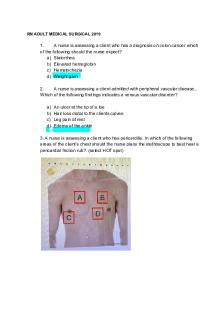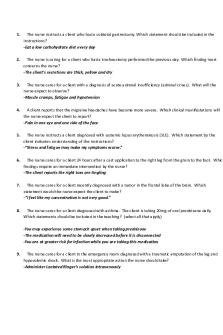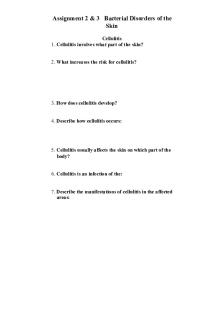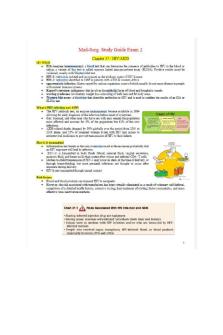Med surg 2 ch 25 notes - Summary Brunner and Suddarth\'s Textbook of Medical-Surgical Nursing PDF

| Title | Med surg 2 ch 25 notes - Summary Brunner and Suddarth\'s Textbook of Medical-Surgical Nursing |
|---|---|
| Course | Primary Concepts Of Adult Nursing II |
| Institution | Nova Southeastern University |
| Pages | 15 |
| File Size | 286.7 KB |
| File Type | |
| Total Downloads | 94 |
| Total Views | 121 |
Summary
book/ lecture notes...
Description
Ch 25- Assessment of Cardiac Function Overview of Anatomy and Physiology ● Three layers ○ Endocardium- inner layer, lines the inside of the heart and valves ○ Myocardium- made up of muscle fibers and is responsible for the pumping action ○ Epicardium- the exterior layer of the heart ● Four chambers- two top chambers are atria and two bottom chambers are ventricles ○ Right side has less pressure, left side has more pressure ● Heart valves ○ Atrioventricular valves- tricuspid (right side of heart), bicuspid/ mitral (left side of the heart) ○ Semilunar valves - aortic semilunar (left side of the heart), pulmonary semilunar (right side of the heart) ● Vasculature ○ The left and right coronary arteries which branch of the aorta supply the heart tissue, which extracts 70-80% of the oxygen ○ Tachycardia can lead to myocardial ischemia in patients due to a decrease in diastolic time for the coronary arteries to perfuse the heart Conduction system (extra notes) -
SA node- primary pacemaker of the heart, in the right atrium, fires 60-100bpm inherently. AV node- secondary pacemaker of the heart Bundle of His- relays the impulse down the septum Perkinje fibers- the conduction impulse gets distributed throughout the ventricles The nodal and perkinje cells generate and transmit electrical impulses, and the myocytes contract
Terms - Cardiac Action Potential ● Depolarization: electrical activation of cell caused by influx of sodium into cell while potassium exits cell
● Repolarization: return of cell to resting state caused by re-entry of potassium into cell while sodium exits ● Refractory periods ○ Effective refractory period: phase in which cells are incapable of depolarizing (phase 0-middle of phase 3) ○ Relative refractory period: phase in which cells require stronger-thannormal stimulus to depolarize (end of phase 3) ● Repeated action of depolarization and repolarization is known as the cardiac action potential
Cardiac Action Potential
Great Vessel and Heart Chamber Pressures
Cardiac Hemodynamics ● HR x SV = Cardiac output - An increase in either of these will cause an increase in CO Hemodynamics
● Stroke volume is influenced by the preload, afterload, and contractility of the heart ● Fluid flows from a region of higher pressure to a region of lower pressure Terms - Cardiac Output ● Stroke volume: amount of blood ejected with each heartbeat by one of the ventricles ○ Primarily determined by preload, afterload, and contractility ● Cardiac output: amount of blood pumped by one ventricle in liters per minute (norm is 4-6 L/min) ● Preload: degree of stretch of cardiac muscle fibers in the ventricles at end of diastole ● Contractility: ability of cardiac muscle to shorten in response to electrical impulse ● Afterload: resistance to ejection of blood from ventricle ● Ejection fraction: percent of end diastolic volume ejected with each heart beat ○ Normal ejection fraction is 55-65% (of the left ventricle), if EF falls to less than 40, the patient likely requires treatment for heart failure Age-Related Changes of the cardiac System (look at table 25-1, pg 679) ● Atria ● Left ventricles- hypertrophy of the heart leads to decreased cardiac output by a reduction in the strength of contraction ● Valves ● Conduction system ● Sympathetic nervous system ● Aorta and arteries ● Baroreceptor response- increase in BP (hypertension) causes an increased firing rate of the baroreceptors in the internal carotids which initiates the parasympathetic nervous system to slow the heart rate. Under periods of hypotension, the firing rates decrease, allowing less parasympathetic (more sympathetic) response which will increase heart rate and vasoconstriction Health History ● ● ● ●
Chief complaint History of Present Illness Past medical, surgical history Past family history
● ● ● ●
Past social history Home medications Nutrition Allergies
Physical Assessment ● General appearance- body weight, LOC ● Skin and extremities- s/s of arterial obstruction (pallor, pain, pulselessness, paresthesia, cold, and paralysis), capillary refill, edema, bruising, clubbing of hands or feet (signaling chronic hemoglobin desaturation) ● Blood pressure-pulse pressure measures (difference between systolic and diastolic.. Norm is 30-40) this is a reflection of the stroke volume ● Arterial pulses- bounding/ +2 is normal, while +4 is bounding and abnormal ● Jugular venous pulsations- can signify right sided heart failure and central venous pressure, which leads to hypervolemia ● Heart inspection and auscultation- locate the apical pulse site and ensure that this pulse is not felt anywhere else. If an apical pulsation is felt anywhere besides the left fifth intercostal space midclavicular line, this can signify ventricular enlargement ○ Auscultation- normal heart sounds are S1 and S2, which signify the closing of the AV valves and semilunar valves ■ S1- tricuspid and mitral valves close ■ S2- closure of the pulmonic and aortic valves ● A split s2 sound is when the two valves do not close simultaneously, this is normal upon inspirations; however when also heard during expiration, this is considered abnormal ■ S3 and s4 sounds and murmurs can be read on page 691 ● General assessment ● Any deviations from the normal? ● Heart as a pump ● Atrial/ventricular filling volumes ● Cardiac output ● Compensatory mechanisms Most Common Clinical Manifestations ● Chest pain- more common for men to experience, while women experience pain in the arm, jaw, have nausea, and neck pain ● Dyspnea
● Peripheral edema, weight gain, abdominal distention due to an enlarged spleen and liver or ascites ● Palpitations ● Unusual Fatigue ● Dizziness, syncope, changes in the level of consciousness ● Pain in other areas of the upper body (arm/s, back, neck, jaw, or stomach) Chest Pain (table 25-2, pg 681) ● ● ● ● ● ● ●
Identify quantity of pain (0-10 SCALE) Identify location of pain Identify quality of pain Radiation of pain Associated s/s- diaphoresis and nausea Duration of pain Assess for other cardiac conditions- HF(pt could have shortness of breath, dysrhythmias (pt can have palpitations) ● Assess for other significant conditions (pp 663-664) ○ Pneumonia, pulmonary embolism ○ Hiatal hernia, GERD ○ Costochondritis ○ Vascular
Assessment ● Medications- nurse tries to get a complete list of the medications the patient takes ● Nutrition- the nurse tries to understand the patients exercise habits and food habits as hyperlipidemia, hypertension, and diabetes are all risk factors for cardiovascular disease. Labs are measures such as blood glucose, glycosylated hemoglobin, total blood cholesterol, HDL, LDLs, BP, height and weight are all useful measurements to assess the patients health status ● Elimination- bowel and bladder habits. Nocturia is common in patients with HF. ○ When patient bears down during elimination, the HR is momentarily slowed due to the vagal response, this can result in syncope (fainting) ● Activity, exercise- fatigue is a common symptom of cardiovascular disease, as well as SOB, so the nurse tries to compare the activity level of the patient from previous months ● Sleep, rest- HY pts can develop orthopnea (a need to sit upright to avoid feeling SOB), or sudden awakening with shortness of breath (paroxysmal nocturnal dyspnea) caused by a fluid shift from fluid entering circulation upon laying in bed,
● ● ● ● ●
causing pulmonary congestion. Sleep-disordered breathing causes SNS activity due to hypoxic conditions from inadequate oxygen intake. Self-perception, self-concept Roles, relationships- social support has been linked to better CVD outcomes Sexuality, reproduction- side effects of meds (beta blockers) can include erectile dysfunction Coping, stress tolerance- pts who are depressed are less likly to be motivated to change their lifestyle habits Prevention strategies
Health Promotion, Perception, and Management Questions ● Ask regarding health promotion, preventive practices ● What type of health issues do you have? Are you able to identify any family history or behaviors that put you at risk of this health problem? ● What are your risk factors for heart disease? What do you do to stay healthy? ● How is your health? Have you noticed any changes? ● Ask regarding health promotion, preventive practices ● Do you have a cardiologist or primary health care provider? How often do you go for check-ups? ● Do you use tobacco or alcohol? ● What medications do you take? Cardiac Specific ● General appearance ● Assessment of skin/extremities ● Signs and symptoms of acute obstruction of arterial blood flow in the extremities referred to as the 6 P’s (pain, pallor, pulselessness, paresthesia, poikilothermia - coldness, and paralysis) ● BP- systemic arterial BP is the pressure exerted on the walls of the arteries during ventricular systole and diastole ● Pulse pressure - difference between systolic and diastolic pressure ● Postural blood pressure changes- gravitational redistribution of approximately 300 to 800 ml of blood into the lower extremities and GI system immediately upon standing ● Arterial pulses ● Pulse rate ● Pulse rhythm ● Pulse amplitude- used to assess peripheral arterial circulation
● Jugular venous distention ● Heart inspection/palpation ● Heart auscultation ● Normal heart sounds ■ S1 AND S2 ● S1- Atrioventricular valve closure ● S2- Semilunar valve closure ● Abnormal heart sounds ■ S3 and S4- use the bell of the stethoscope ● S3- heard early in diastole during rapid ventricular filling, immediately after S2, this is a normal finding in young adults and children up to 35/40 years of age ● S4- occurs late in diastole, during atrial systole. Heard just before S1 ■ Assessment of lungs ■ Assessment of abdomen Diagnostic Interpretation Laboratory Evaluation ● ● ● ● ●
Assists in making a diagnosis Screens for risk factors associated with CAD Establishes baseline values Monitor responses to therapy Assess for abnormalities that affect prognosis
Laboratory Tests: Cardiac Biomarkers- **we will insert the normal ranges on the other document for lab values**** The diagnosis of MI is made by evaluating the history and physical exam, 12 lead ECG, and the results of lab tests that measure serum cardiac biomarkers These are released and can be abnormally high from myocardial cell necrosis resulting from trauma or ischemia: ● Creatinine Kinase (CK) ● Creatinine Kinase Isoenzymes (CK-MB) ● Proteins ● Myoglobin
● Troponin T and Troponin I Laboratory Tests: Hematology, Chemistry, Coagulation Studies ● Lipid profile ○ cholesterol, triglycerides, and lipoproteins are measured to evaluate a person’s risk of developing CAD ● Brain (b-type) natriuretic peptide (BNP) ○ Hormone that helps regulate BP and fluid volume ○ Released from the ventricles in response to increased preload and a resulting elevated ventricular pressure ○ BNP level greater than 100 is suggestive of HF ● C-reactive protein - produced by the liver in response to systemic inflammation ○ High sensitivity CRP of 3mg/L signifies greater risk for CVD ● Homocysteine- amino acid that is linked to the development of atherosclerosis because it damages the endothelial lining of arteries and promotes thrombus formation ● Blood chemistries ○ BNP ● Coagulation studies ○ PTT ○ PT ○ INR ● Hematologic studies ○ CBC (WBC, Hgb, HCT)
Diagnostic Evaluation Imaging ● Chest x-ray ○ Size, position, contour of heart ○ Reveals cardiac and pericardial calcifications ○ Assists in diagnosing other conditions ● Electrocardiography ○ Electrical activity of the heart (12 leads, looks at 12 different views) ○ Diagnoses ■ Dysrhythmias ■ Conduction abnormalities ■ Chamber enlargement ■ Myocardial ischemia, infarction, injury
■ Electrolyte disturbances Electrocardiography : Continuous ● Standard of care ● Monitors more than one lead at a time ● Monitors for ST segment changes ● ST-segment depression signifies myocardial ischemia ● ST-segment elevation signifies evidence of an evolving MI ● Provides visual and audible alarms ● Interprets and stores alarms ● Trends data over time ● Prints copy of rhythms
Cardiac Stress Testing ● Normally: cardiac arteries dilate to four times their usual diameter in response to increased metabolic demands for oxygen and nutrients ● Atherosclerotic vessels dilate less=> ischemia ● Abnormalities are likely to be detected during times of increased demand (stress) ● Cardiac stress test procedures are noninvasive ways to evaluate response to stress Stress test determines the following 1. 2. 3. 4.
Presence of CAD Cause of chest pain Functional capacity of the heart after an MI or surgery Effectiveness of antianginal or antiarrhythmic medications
5. Occurrence of dysrhythmias 6. Specific goals for physical fitness program ● Contraindications ● Acute MI within 48 hours ● Uncontrolled dysrhythmias ● Severe aortic stenosis ● Acute myocarditis or pericarditis ● Severe HTN ● Suspected left main disease ● Heart failure ● Unstable angina ● Complications ● AMI ● Cardiac arrest ● Heart failure ● Unstable angina ● ACLS training required as well as equipment ready to provide life saving treatment
Exercise Stress Testing ● Walks on a treadmill, bike, arm crank ● Exercise intensity increases ● Patient monitoring (2 or more leads for EKG, VS) ○ Monitors rate, rhythm, and ischemic changes, as well as chest pain, physical appearance, dizziness, cramping, skin temp, BP ● Target HR achieved or if the patient is experiencing signs of myocardial ischemia→ test is terminated ● Further testing, cardiac catheter, may be warranted it pt develops chest pain, extreme fatigue, decrease in pulse rate, dysrhythmias... Pharmacologic stress testing ● Physical disability/deconditioned ● Persantine and Adenocard IV ○ Mimic effects of stress ○ Dobutamine if no tolerance to exercise, if the pt cant tolerate not taking theophylline (as it blocks the effects of vasodilating agents)
Nursing Interventions ● NPO x 4 hours (book says at least 3 hours) ● Avoid stimulants (caffeine, tobacco), even caffeine- free coffee and tea and carbonated beverages ● Meds with sips of water ● May instruct to hold beta blocking agents, theophylline, aminophylline before test ● Appropriate attire- rubber soles shoes, sneakers, clothes ● Sensations with medications Cardiac Evaluations ● Transthoracic echocardiography ● Ultrasound test that is used to measure the ejection fraction and examine the sze, shape, and motion of cardiac structures ● Useful for diagnosing etiology of heart murmurs, and chamber sizes, as well as analyzing heart valves ● Useful for monitoring for leaky valves and blood movement ● Noninvasive ● Ejection fraction ● Size, shape and motion of cardiac structures ● Pericardial effusions ● Determines chamber size ● Etiology of heart murmurs ● Function of heart valves ● Ventricular wall motion ● Transesophageal echocardiography ● Use of a transducer put into the patient's mouth in the esophagus for clear image ● Topical anesthetic agent and moderate sedation is used ● Used for cardiovascular disease- HF, valvular heart disease, dysrhythmias ● Myocardial perfusion imaging ○ Commonly performed after an acute MI to determine if arterial perfusion of the heart is compromised during activity and to evaluate the extent of myocardial damage ○ Area that show less perfusion are called ‘defects’ ○ Fixed defect is an area that does not change size during times of res and stress ○ Reversible defect- the area of no perfusion disappears upon rest ● Computerized tomography (CT)
○ Uses x-rays that provide accurate cross-sectional ‘virtual slices of specific areas ○ Creates three dimensional images ○ Coronary CT angiography uses contrasting agent to better visualize arteries for stenosis, aortic aneurysms ● MRI ○ Couldn't find MRI in chapter ● PET scan ○ Tracers are injected into IV ○ Provides detailed three dimensional images of compounds ○ Analyzes glucose metabolism to the degree of blood flow ■ Ischemic but viable tissue will show decreased tissue but elevates metabolism---revascularization is needed to restore the working tissue
Cardiac Catheterization ● Invasive diagnostic procedure ● Radiopaque arterial and venous catheters advanced into right and left heart (left heart uses contrasting agent to better visualize the coronary arteries) ● Guided by fluoroscopy ● Gold standard for diagnosis= ● CAD ● Coronary artery patency ● Determines extent of atherosclerosis ● Determines whether revascularization may be necessary ● Pulmonary artery HTN ● Valvular heart disease Complications ● Anaphylaxis (iodine) ● Contrast induced nephropathy[CIN] (increase of baseline creatinine by 25% within 2 days of procedure)- pts with hypotension, HF, dehydration, chronic kidney disease, diabetes ● Bleeding ● Manual pressure ● FemoSTop- compression device places over femoral artery injection site, stays in place for 30 minutes ● QuickSeal/AngioSeal
● Sutures Nursing Interventions (read chart 25-6 pg 705 for further patient education) ● Fast 8-12 hours prior ● Transportation home ● Explanation of procedure- palpitations may be felt when the tip of the catheter touches the endocardium, cough and beed breath with contrasting agent is released ● Observe catheter access site for bleeding/hematoma ● Neurovascular assessment of extremity ● Screening for dysrhythmias ● Postprocedure- bedrest for 2-6 hours, positioning (for femoral puncture site, the HOB not to exceed 30 degrees and affected leg straight) ● Monitor cardiovascular status/chest pain/VS ● Monitor for CIN- creatinine levels elevated, keep IV fluid going to maintain hydration and flush out contrasting agent
Hemodynamic Monitoring -
Direct pressure monitoring systems that continually assess critically ill patients
Central Venous Pressure (CVP) ● Measures filling pressure in right atrium/ventricle at end of diastole (PRELOAD) ■ Hypervolemia ■ Hypovolemia- from dehydration, excessive blood loss, vomiting, diarrhea, and overdiuresis ○ CVP 2-6 mm Hg (normal value) ● Nursing care on table 25-5 (pg 707)
Pulmonary Artery Pressure Monitoring ● ● ● ● ● ●
Assess left ventricular function Diagnose ethology of shock Evaluate response to therapy Administer medications Place pacemaker Measures cardiac chamber pressures
Phlebostatic Level- level of the right atrium has to be in line with the level of the stopcock of the transducer of the sytem
Pulmonary Artery Catheter and Pressure Monitoring System
Intra-arterial Blood Pressure Monitoring ● Obtains direct and continuous BP measurement in critically ill patients with severe hypertension or hypotension ● Obtain arterial blood gas specimen ● Radial artery...
Similar Free PDFs

ATI MED SURG Notes FOR Nursing
- 33 Pages

Med surg - notes
- 28 Pages

Kaplan med surg 2
- 8 Pages

Med SURG; assignment 2
- 9 Pages

Summary Textbook CH 15
- 5 Pages

Med Surg 2 FINAL EXAM Notes
- 107 Pages
Popular Institutions
- Tinajero National High School - Annex
- Politeknik Caltex Riau
- Yokohama City University
- SGT University
- University of Al-Qadisiyah
- Divine Word College of Vigan
- Techniek College Rotterdam
- Universidade de Santiago
- Universiti Teknologi MARA Cawangan Johor Kampus Pasir Gudang
- Poltekkes Kemenkes Yogyakarta
- Baguio City National High School
- Colegio san marcos
- preparatoria uno
- Centro de Bachillerato Tecnológico Industrial y de Servicios No. 107
- Dalian Maritime University
- Quang Trung Secondary School
- Colegio Tecnológico en Informática
- Corporación Regional de Educación Superior
- Grupo CEDVA
- Dar Al Uloom University
- Centro de Estudios Preuniversitarios de la Universidad Nacional de Ingeniería
- 上智大学
- Aakash International School, Nuna Majara
- San Felipe Neri Catholic School
- Kang Chiao International School - New Taipei City
- Misamis Occidental National High School
- Institución Educativa Escuela Normal Juan Ladrilleros
- Kolehiyo ng Pantukan
- Batanes State College
- Instituto Continental
- Sekolah Menengah Kejuruan Kesehatan Kaltara (Tarakan)
- Colegio de La Inmaculada Concepcion - Cebu









